Dog breeds with African origins are some of the sturdiest and most intelligent in the world. After all, it is not easy to live alongside many of the planet’s most fearsome predators like lions, tigers, and hyenas. And with the unforgiving terrain, these dogs have to be tough and resilient. Curious about what these dog breeds are? Here are 10 canine breeds that are the pride of the African people.
Basenji
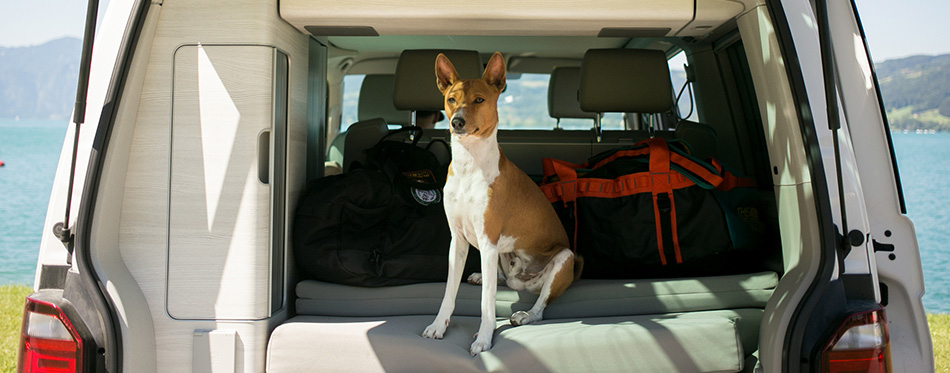
Kennel clubs around the world classifies the Basenji as a sighthound. This is a rather odd classification, considering the breed is small at only 17 inches. It also lacks the long neck and legs of other sighthounds like the Saluki and the Afghan Hound. Nobody can question the breed’s hunting instincts, however. And this is what matters, especially if you live in the Congo Basin where many fierce predators live.
Known for its yodel-like vocalization, the Basenji is very protective of its territory. It does not bark because the dog does not want predators to know that there are people nearby. The yodel sound it produces tricks predators into thinking that another wild animal is making the sound.
Basenjis are curious and very alert. They have to. Living in the Congo is never easy with wild animals roaming about. There are poachers, too. It is, however, very energetic. It likes to play with one particular member of its human family; although it can still show affection to the rest. It doesn’t do well around non-canine pets and it would be wise to keep your other pets out of the Basenji’s way. The Basenji is great only for individuals who know how to train an independent-minded dog.
Boerboel
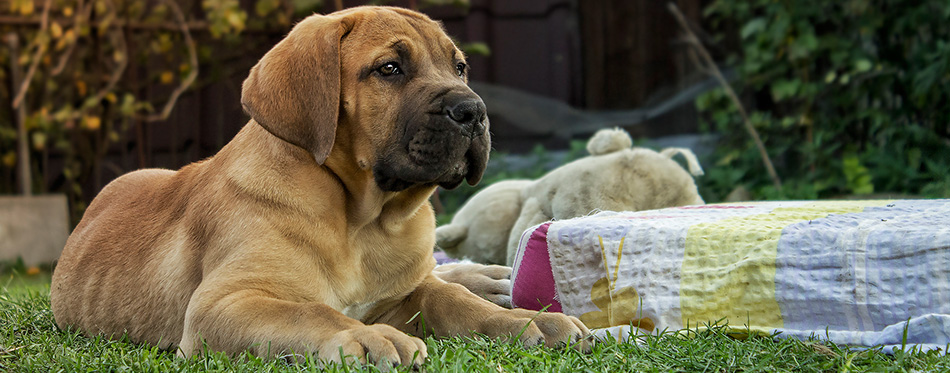
You do not want to wrestle with a Boerboel. This South African breed of dog is a Molosser type of dog that has a bite force of 800 PSI. To put that into perspective, a lion has a bite force of about 650 PSI. A tiger, on the other hand, has a bite force of about 1050 PSI. This makes the South African Mastiff as one of the world’s most powerful canine breeds.
Weighing up to 198 lbs and standing up to 28 inches, the Boerboel uses its imposing presence to scare would-be attackers to its master’s property. The breed is a guard dog; although it also doubles as a working farm dog. They respond well to training, although they need a firm leader when it comes to teaching them things in the house.
Despite their size, Boerboels have a soft spot for children. They are like the Newfoundlands in the Northern Hemisphere, serving as nannies to the children of their human masters. This is a very loyal breed. In fact, it is so loyal that it can act like a Velcro. On a positive note, this means the Boerboel will never wander off on its own.
Rhodesian Ridgeback
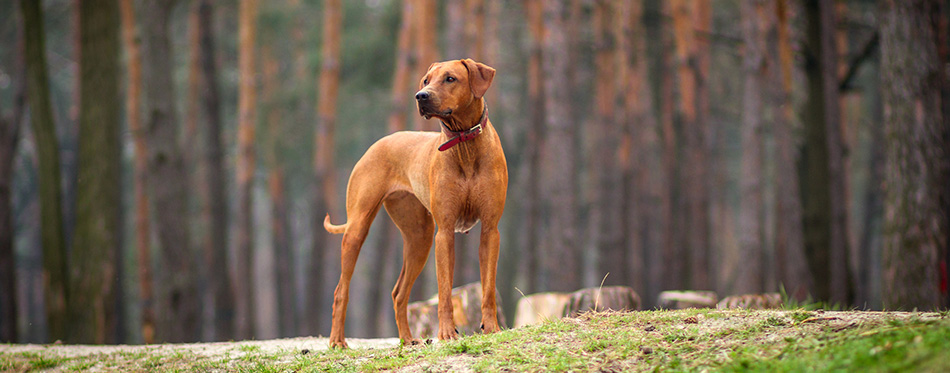
South Africans call the Rhodesian Ridgeback the African Lion Dog and for good reason. This is one of the very few breeds of dog that can keep the lord of the jungle at bay. It does this so that the lion will not escape prior to the arrival of the dog’s hunter-master for the kill. Fanciers believe that the Rhodesian Ridgeback’s descendants are 17th century hunting dogs. People describe the dog’s ancestors as ugly, but very ferocious. Its ferocity can outclass that of a lion, earning for itself the name “African lion dog”.
In spite of their fearsome reputation, Ridgebacks are very loyal. They make excellent companions for individuals who know how to handle a dog with an imposing presence. This breed also has an air of confidence in it, but never arrogant. It is strong-willed and independent-minded. Hence, early socialization and training is a must if you want the Ridgeback not to control your life.
Having descended for guard dogs, Rhodesian Ridgebacks are aloof around strangers. If not trained, they can be very aggressive as this breed is territorial. Socializing and training it early on should help temper their aggressive tendencies with restraint.
Sloughi
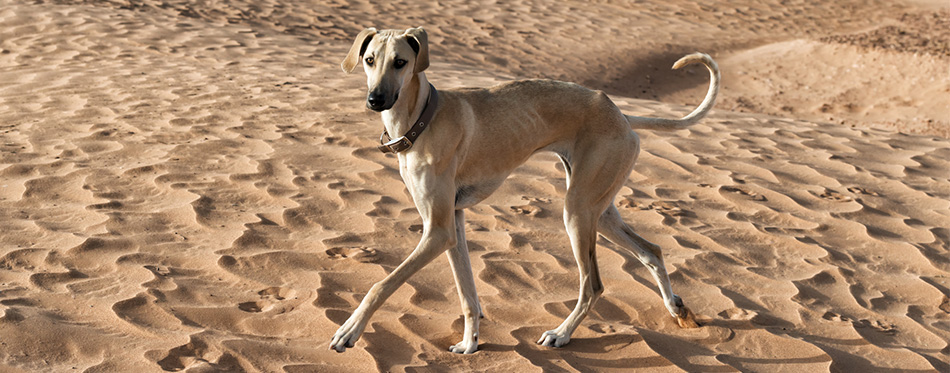
This North African breed bears some resemblance to the Saluki and the Afghan Hound. It has a long muzzle, long neck, slender body, and long limbs. There is no mistaking the Sloughi for a sighthound. Hunters use Sloughis in hunting hare, jackals, gazelles, foxes, and wild pigs. Like the Afghan Hound and the Saluki, the Sloughi is treasured for its hunting skills, endurance, agility, and speed.
Like other sighthounds, the Sloughi is a pursuit dog. It can run at an average speed of 37 MPH. While slower than the Saluki’s 42.8 MPH speed, the Sloughi can still outrun many wild animals in North Africa. In addition to its amazing speed, it can also jump very high.
The Sloughi has the Afghan Hound’s noble attitude and the Saluki’s grace and class. It is an exciting combination of temperaments that make this breed a great companion for the family. Sloughis are not good at socializing with strangers, however. They are not aggressive; only aloof. The breed is quite sensitive, too. Hence, corporal or harsh training methods are a big no-no. Only positive reinforcement training methods will work with this dog.
Azawakh
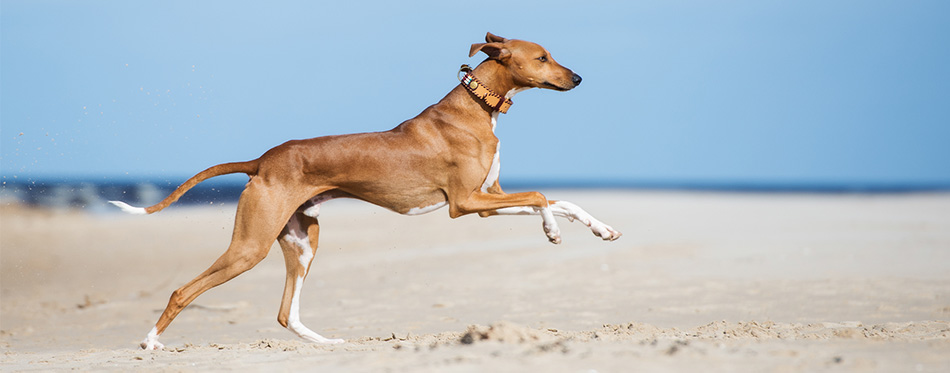
If you were to put the Azawakh alongside the Sloughi, you’d think they are the same dog. They’re not. First of all, the Sloughi’s origins are from the Mediterranean shores of North Africa. Further down south, in a region called “Sahel”, is where the Azawakh has its origins. Second, the Azawakh has a characteristic white coloring on all of the dog’s feet. Other than that, it is easy to confuse the Azawakh for the Sloughi.
While the Azawakh is a sighthound, they work best as a pack, like Beagles. They bump down their quarry with their hindquarters. They can run very fast, too; although not as fast as the Sloughi. Azawakhs are also excellent guard dogs. When on a hunt, any Azawakh that sense danger will sound off a characteristic bark. This alerts the rest of the pack. They will then work as a unit to either attack or chase the predator.
In its native land, the Azawakh is a protector. Outside Africa, the breed is a loyal companion. It is a gentle breed that can show extreme affection for its family. Socialize it well and you can turn this dog into your cat’s new best friend.
Abyssinian Sand Terrier
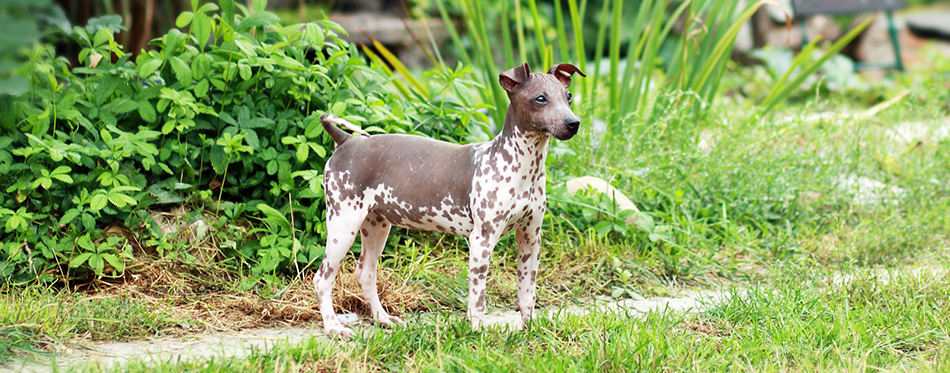
Many individuals consider the Chinese Crested as having African ancestry. However, proving its origins is quite difficult. There is another hairless breed that resembles the Chinese Crested and one that we can be certain of its African roots. The Abyssinian Sand Terrier (AST) is also known as the African Hairless Dog. It does not look as elegant as the Chinese Crested, but it sure can charm its way to the hearts of its people.
The AST does not have hair on its body, except towards the end of its tail and on its skull. There are, however, some dogs that are completely bald. This breed can have a mottled appearance, in addition to pale sandy, black, bronze, grayish-black, and elephant-gray coloring. Abyssinian Sand Terriers have large, bat-like ears like the French Bulldog.
Like most African dog breeds, the Abyssinian Sand Terrier is fearless. It will never back down from a perceived threat. While it is courageous, it can also show its willingness to please.
Coton de Tulear
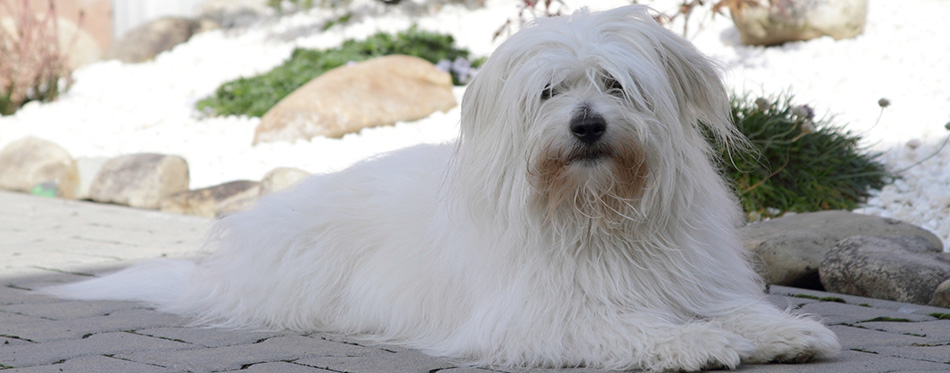
The black sheep in our list of African dog breeds, the Coton de Tulear is a small canine breed. It originated from one of Madagascar’s key cities, Tulear. They call it “Coton” because of its fluffy, cotton-like coat.
Because Madagascar is an island off the coast of East Africa, you don’t expect the ferocious beasts of the mainland to be present. It is for this reason that the Coton de Tulear is Africa’s most playful and most affectionate breed. There is no hint of aggression in this breed. They have the clownish personality of a Poodle and the playfulness of a Golden Retriever.
This canine breed can be very vocal. However, its vocalization is not always to warn you of a threat. Instead, it vocalizes to add more fun to its antics. Coton de Tulears love to perform in front of its owner’s guests. It will stand up on its hind legs and walk like bipeds. They love to swim, too. One thing you should keep in mind about the Coton de Tulear is that it feels more alive as the sun sets on the horizon.
Aidi (Atlas Mountain Dog)
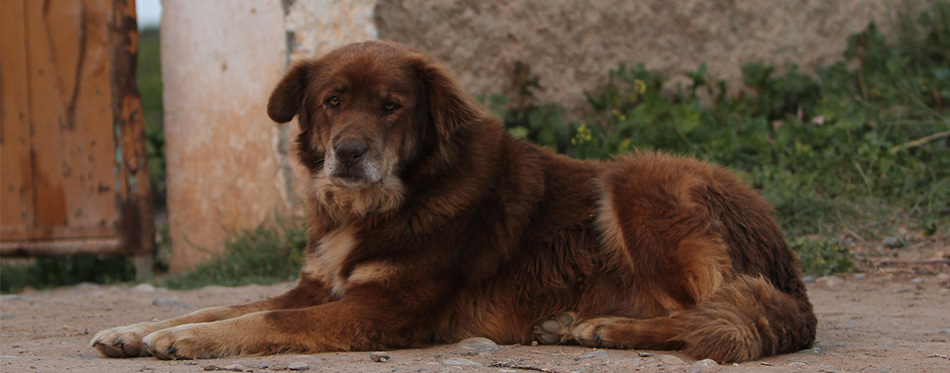
High up in the Atlas Mountains lives one of the continent’s most courageous dogs. The Aidi has one purpose in its existence – to protect its human family and their property against wildcats and other predators in North Africa. As a protector of North African nomadic tribes, the Aidi has a certain level of vigilance that very few other breeds can match. Families often put the most aggressive Aidis in the camp perimeter at night, knowing the courage of this dog will give them a good night’s sleep.
Unfortunately, many of the tribes do not regard the Aidi as noble as the Sloughi. So far, only the Moroccans have shown appreciation for the breed’s remarkable characteristics. It is for this reason that the Aidi is now taking up various roles. The Atlas Mountain Dog is now a police dog, a gun dog, and a family companion.
Being a working breed, the Atlas Mountain Dog requires plenty of exercise and stimulating activities. It loves learning new tricks; not because it wants to please its owners, but because it doesn’t like getting bored. So, if you are interested in getting an Aidi for your home, you must have more than a bag of tricks to teach the dog; lest you discover how destructive this breed can be.
Africanis
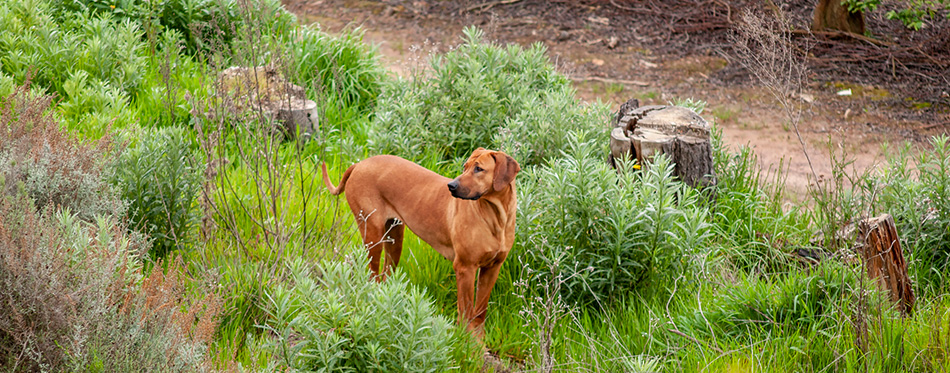
Only the Kennel Union of South Africa recognizes the Africanis as an emerging breed. Nevertheless, this has not dampened the spirits of those in the Africanis Society of South Africa to advance the development of the breed.
The Africanis comes in various names like Bantu Dog, Tswana Dog, Katali, and Khoikjoi Dog. It has a short coat and well-defined muscles. In some dogs, there can be a ridgeback. Unfortunately, such a feature in the canine is often associated with the presence of a dermoid sinus. As such, breeders do not use ridgebacked Africanis for fear of passing the mutant gene to the puppies.
When it comes to its temperament, the Africanis can be very sociable and friendly. While it is independent-minded, the canine breed is easy to train. They can turn very grumpy when they reach their senior years, however. The Africanis is not a popular dog, but it deserves its place as one of Africa’s original dogs.
African dog breeds make perfect companions for those who love sturdy and intelligent pets. Most of these breeds, however, require a dog owner who knows how to train and socialize strong-willed canines.
Armant (Egyptian Sheepdog)
The Armant does not stand taller than 23 inches. But, when it comes to protecting its family, no predator is large enough to scare the wits out of this Egyptian sheepdog. Such is the description that Armant owners provide of this breed. After all, its forebears were the valued canine guards of Egyptian royalties. Through the years, other Egyptians took the dog to their homes. It proved its mettle in protecting the family and property of its owners. This work ethic remains strong to this very day.
The Egyptian sheepdog is very loyal to its owner and his family. It can be very territorial when not trained as a puppy. Training the Armant requires a firm yet positive approach. Like most African canine breeds, the Egyptian sheepdog has an independent streak. This is a dog that’s not suited for first-time dog owners.
The Armant has an even temperament and a sociable nature, nonetheless. This makes it an adorable companion for families with children. When not on duty, the dog loves to play with other animals as well as the children of its human family.
Source:
- Africa : Native Dog Breeds – Native Breed.org

